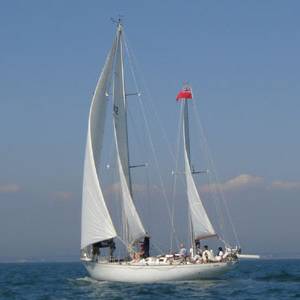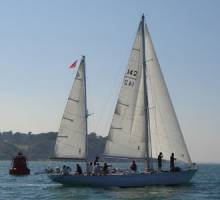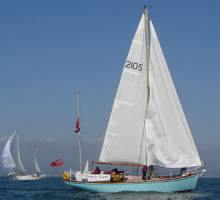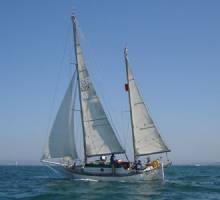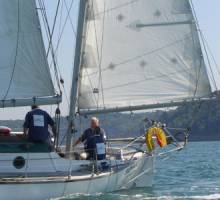
Gipsy Moth IV, Lively Lady and Suhaili race together at last!
Friendly races were held today in the Solent between 3 famous Round the world yachts, Gipsy Moth IV, Lively Lady and Suhaili.
This the first time these yachts have ever have been seen together under full sail.
The Boatshed.com launch was on hand to get some great photos of the action.
See all the photos below
Gipsy Moth IV
Specification Ketch. 54 × 10.5 × 7.' Tons: 11.5 disp; 18 TM. Comp.: 1. Des.: Illingworth & Primrose. Built: Camper & Nicholsons, Southampton, Eng. 1965.
A pioneer of long-distance flight, Francis Chichester was the second person to fly solo from England to Australia, in a Gipsy Moth airplane. When he later turned to single-handed long-distance sailing, he named his four boats (II to V) for his plane. It was in Gipsy Moth IV that he achieved lasting fame for his one-stop solo circumnavigation. Among Chichester's other ambitions was to equal the average passage of the wool clippers outward bound to Australia via the Cape of Good Hope, which he calculated to be 100 days. Although he fell short of this goal, Gipsy Moth IV—"about as unbalanced or unstable a boat as there could be"—made phenomenally good time. Sailing from Plymouth on August 28, he rounded the Cape of Good Hope 58 days out and entered Sydney Heads on December 12, 1966, after a passage of 14,100 miles in 107 days. This was 20 days better than the average speed for all clippers, not just for the fastest. After 48 days spent refitting and provisioning, he set out again, and after a knockdown in the Tasman Sea, he sped through the roaring forties, rounding Cape Horn 50 days out and returning to a hero's welcome at Portsmouth in an overall time of 274 days. A national hero, Chichester sailed Gipsy Moth IV up the Thames and was knighted by Queen Elizabeth II with the same sword that Elizabeth I used to knight Sir Francis Drake for his exploits in Golden Hind, the first English ship to sail around the globe, in 1581.
Lively Lady
Specification Cutter 36 × 9.2 × 6.6 Tons: 13.75 disp. Hull: wood. Comp.: 1. Des.: Frederick Shephard. Built: S. J. P. Cambridge, Calcutta, India. 1948.
Lively Lady was a cruising yacht built for and by S. J. P. Cambridge in India in 1948. Her second owner was greengrocer Alec Rose, who bought her in 1963 to compete the following year in the second solo transatlantic race from England to the United States. Lively Lady placed fourth with a crossing of thirty-six days. Two years later Rose embarked on a solo circumnavigation, his intent—like that of Sir Francis Chichester in Gipsy Moth IV—being to complete the passage with only one stop. Rerigged by Illingworth and Primrose, Lively Lady's primary new feature was the addition of a boomless mizzen mast from which to set a mizzen staysail. After several false starts in the spring, he departed Portsmouth on July 16, 1966. Lively Lady made good time, passing the Cape of Good Hope on October 8 and arriving at Melbourne on December 17. After a month-long layover, he sailed on January 14. On the eleventh day out, a masthead fitting parted and he was forced to put in to the southern New Zealand port of Bluff for repairs that lasted five days. He rounded Cape Horn on April 1, and returned to Portsmouth on July 4, 1968. Like Chichester before him, Rose was knighted for his achievement by Elizabeth II.
Suhaili
Specification Ketch. 32 × 11.1 × 5 Tons: 14 TM. Hull: wood. Comp.: 1-5. Mach.: aux. Des.: Production Promotions, Ltd. Built: Colaba Workshop Ltd., Bombay, India; 1964.
Merchant marine officer Robin Knox-Johnson was stationed in India with the British Steam Navigation Company when he built the teak-hulled ketch Suhaili. (The name is Arabic for the southeast wind.) Ordered home for work on the run between England and Africa, he sailed Suhaili the 12,000 miles back to London with his brother and a friend. A year later, motivated in part by rumors that the French yachtsman Eric Tabarly was planning a nonstop, solo circumnavigation—and determined that an English sailor should be the first—Knox-Johnson began preparing for the same. In the meantime, the Sunday Times put up the Golden Globe award for the first person to accomplish this feat. Between June 1 and October 31, 1969, six boats set sail: John Ridgway's English Rose, Chay Blyth's Dytiscus, Suhaili, the French Bernard Moitessier's Joshua, and two English trimarans, Donald Crowhurst's Teignmouth Electron and Nigel Tetley's Victress.
Suhaili sailed third, departing Falmouth on June 14, 1968. Over the course of the next 310 days, she would log an average of 96.2 miles per day, following what Sir Francis Chichester had called the clipper route on his one-stop circumnavigation in Gipsy Moth IV. Suhaili did not have an easy time of it. A knockdown off the Cape of Good Hope rendered her radio inoperable for most of the rest of the voyage. Crossing the Indian Ocean, Knox-Johnson decided to sail through Bass Strait rather than south of Tasmania, and there Suhaili took another knockdown that resulted in damage to the water tanks, tiller, and self-steering gear. Pressing on, he crossed the Tasman Sea and sailed through Foveaux Strait between New Zealand's South Island and Stewart Island, only to run aground on a sandbar near Dunedin. (The challenge judges determined that this did not constitute a stop.) Shortly after this he radioed his sponsors, the Sunday Mirror and True magazine:
I am beginning to wonder how much of the original boat I am going to be left with by the time I reach home. So far I have written off the self-steering gear, two tillers, a jib, a spinnaker, half the cooking stove, and the water tank. The cabin has shifted and leaks, and its canvas cover is cracking up.
This upbeat transmission was his last for 134 days, during which Suhaili ran her easting down in the Roaring Forties, rounded Cape Horn on January 17, 1969, and sailed up the Atlantic. There was no word of Suhaili until April 5, when a British tanker spoke her about 500 miles west of the Azores. Thirteen days later she was off the coast of England, but four days of adverse gales kept Knox-Johnson from making port until April 22, when he landed at Falmouth, having sailed 30,123 miles in 313 days.
While his achievement garnered Knox-Johnson the Golden Globe, his fellow sailors seemed poised to complete the circuit in faster time. As it happened, none finished. Blyth was forced to land in South Africa. Having averaged 110.6 miles per day, Tetley's Victress broke up after 247 days at sea, 1,200 miles from Plymouth. After rounding Cape Horn, Moitessier thought better of racing and decided to stay in the Roaring Forties before turning north for Tahiti, sailing 37,455 miles in 301 days without touching land. Most curious of all was the fate of Donald Crowhurst, whose Teignmouth Electron was found drifting in the Atlantic on July 10, only days after he had slipped over the side.
Suhaili was repaired and Knox-Johnson resumed long-distance voyaging in her. In 1989, he crossed the Atlantic using only fifteenth-century navigational techniques and instruments.
Information courtesy of Ships of the World: Houghton Mifflin Company
